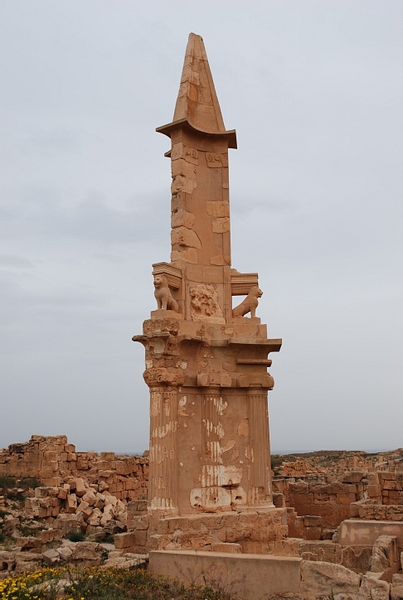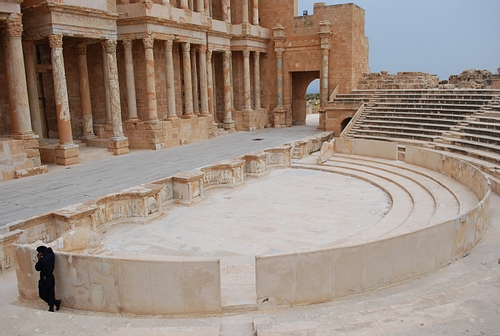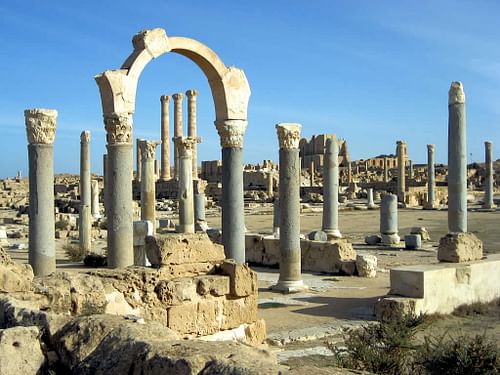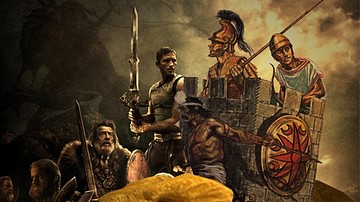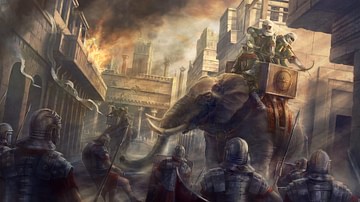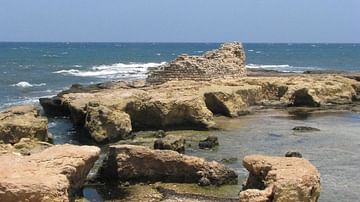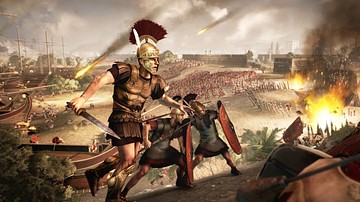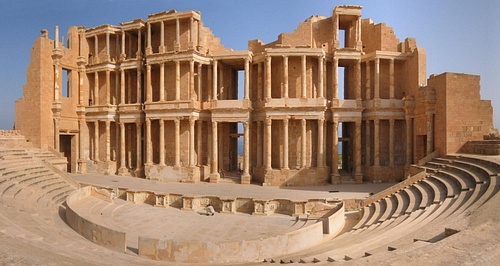
Sabratha was an ancient port city on the coast of North Africa (in modern-day Libya). The site was originally inhabited by the indigenous Berber Zwagha tribe in the 8th century BCE (according to the 11th-century CE historian al-Bakari) who gave it their name. It became a Carthaginian colony c. 500 BCE, known as Tsabatan, and part of a tri-city trade network known to the Greeks as the Emporia. It was taken by the Numidians under the reign of their king Masinissa (c. 202-148 BCE) following Carthage's defeat in the Second Punic War (218-202 BCE) and was later claimed by Masinissa' grandson Jugurtha (r. 118-105 BCE) as part of his kingdom.
The city was among those taken by Rome following Jugurtha's death in 105 BCE, and during the reign of Julius Caesar (48-44 BCE), it was included as part of the province of Africa Nova. It continued its role as an important center for trade along with the cities which had made up the earlier Emporia – Leptis Magna and Oea (modern Tripoli) – and the area was known by the 3rd century CE as the Regio Tripolitania (“region of the three cities”). Sabratha was the site of the trial of the famous Berber-Roman poet Lucius Apuleius (l. c. 124 - c. 170 CE, author of The Golden Ass) for witchcraft in 158 CE which produced his brilliant defense, Apologia, still studied in the present day.
Sabratha supplied Rome with many of its most exotic animals and commodities via a direct trade route to the interior of Africa to the Oasis of the Ghadames, a skillful tribe of hunters and artisans, and Rome rewarded the city with increasing development in the form of a theater, amphitheater, temples, and monuments throughout the 2nd and 3rd centuries CE. The ruins of these structures have made Sabratha a popular tourist destination for the past 50 years, and the site is considered the best-preserved outside of Italy. It was declared a World Heritage Site in 1982 CE.
Carthaginian Sabratha
Evidence of early Berber habitation comes primarily from Arabian historians such as al-Bakari who cite tribes including the Zwagha, Zwara, and others as native to the region. The modern-day city of Zwara, to the west of Sabratha, is only one attestation to this claim. Nothing is left of whatever early structures the Zwagha may have built but, knowing the North African Berber coastal tribes' reliance on the sea for sustenance and trade, some sort of community would have existed at the site before the arrival of the Carthaginians.
Carthage, to the east on the coast (in modern-day Tunisia), was the greatest power in the Mediterranean before the rise of Rome following the First Punic War (264-241 BCE) and had the largest fleet of vessels on the sea. They founded colonies like Sabratha to extend their reach in trade after first founding Oea and Leptis (known by the Romans as Leptis Magna to differentiate it from a smaller city of the same name). All three of these ports flourished under the Carthaginians who encouraged trade with the country's interior tribes to provide exotic commodities to other nations.
Carthaginian Sabratha was one of their most lucrative ports thanks primarily to the direct route between the city on the coast and the Oasis of the Ghadames in the interior. The city steadily developed as greater demand grew for the goods the Ghadames could deliver. Sabratha began as mud-brick structures, mostly residential, on stone foundations before the builders began working primarily in stone. The population increased and the city grew, adding a market, temples, and cemetery including a tophet (children's cemetery). One testament to the wealth of Sabratha under Carthage, still extant, is the Mausoleum of Bes, probably the most famous structure at the site in the present day after the theater's ruins.
The Mausoleum of Bes was commissioned by a Punic citizen and constructed along the lines of Punic architecture but incorporates aspects of different cultures. The mausoleum takes its modern-day name from Bes, the Egyptian god of fertility and protection, whose image features prominently on the structure. The name of the citizen it was built for is unknown. Egyptian motifs appear on the structure (such as a false door and winged solar discs) as well as the Greek hero Hercules (who, like Bes, is seen defeating lions – in his case the famous Nemean Lion) and kouroi (young men) statues as well as Ionic columns. There are Phoenicio-Cypriote capitals to the columns and the entire monument is crowned with a pyramid. Scholar Richard Miles describes the effect the monument would have had on a Greek visitor to the city:
To any Greek contemporary, the Sabratha mausoleum would have managed to look both familiar and alien at the same time. Many of the mausoleum's artistic and architectural elements – including the capitals, columns, kouroi and metopes – hailed from the Greek artistic and architectural canon. Furthermore, the metopes were covered in brightly painted stucco in the same fashion as their Greek equivalents. These colours were used to particularly striking effect on the central panel. The naked flesh of Bes was deep pink. The brilliant white of his loincloth and teeth highlighted the red of his lugubrious lips and the cobalt blue of his beard. Colour also added greatly to the expressiveness of the lions, with their blue manes resting on deep yellow bodies. The turquoise of their lifeless eyes and the red of their lolling tongues set against the brilliant white of their teeth contrasted with the flaccidity of death. (19-20)
The monument, again according to Miles, disregards classical composition for a completely innovative presentation of potent symbolism from Greek, Punic, and Egyptian religious and cultural tradition. The mausoleum represents the diversity of the population of Sabratha at the time but is also one of the few remaining genuinely Punic creations. Punic art regularly drew on the symbolism of other cultures, but this is often overlooked because so little of it remains (Carthage having been destroyed by Rome at the end of the Punic Wars in 146 BCE). The Sabratha monument is considered as important as it is for this very reason; it is among the few extant representations of genuine Punic art and what art meant to that culture. Miles comments:
The Sabratha mausoleum stands as a stunning monument not to the derivative nature of late Punic culture, but to the extent to which the Punic world was part of a wider economically and culturally joined-up community that spanned much of south-western Europe and North Africa long before it was politically united under the imperial aegis of Rome. It was not a world founded on the overwhelming political or military supremacy of one particular power, but a much looser network made up of the diverse peoples – Punic, Greek, Etruscan and others – who lived along its shores. These different ethnic groups were initially linked together by maritime trade – the engine through which goods, people, techniques, and ideas flowed across the ancient Mediterranean. (21)
Sabratha under the Carthaginians was a metropolitan city whose prosperity seemed boundless until it was interrupted by war. In 264 BCE, Rome was still a small city establishing itself in Italy with no fleet to speak of and Carthage ruled the seas. Rome and Carthage both had claims to the island of Sicily and, when two Sicilian kingdoms went to war with each other, Carthage and Rome were drawn into the conflict and declared war on each other. Rome quickly developed a naval fleet and learned to fight at sea. The First Punic War left Carthage in defeat and owing huge reparations to Rome which now became the Mediterranean superpower. Sabratha would have suffered along with other Carthaginian colonies and Carthage itself in the aftermath of the war.
Rome Takes Sabratha
The turning point for the city was the Second Punic War (218-202 BCE), the best-known of the three, in which Hannibal Barca terrorized Rome and Scipio Africanus saved it. Although Sabratha itself was not involved in the conflict, it changed hands afterwards when Masinissa of Numidia added it to his kingdom. Masinissa had originally been an ally of Carthage but, seeing that Rome was going to win, changed sides. As a reward for his help, Rome let him do whatever he wanted in North Africa and Masinissa established his great Kingdom of Numidia.
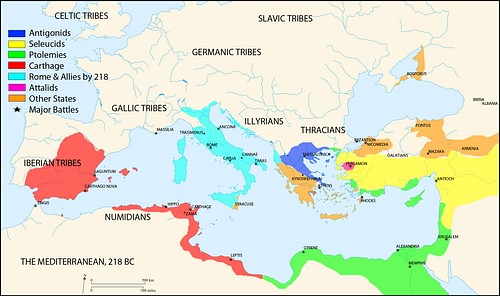
This kingdom declined after his death but was reunited and reinvigorated under his grandson Jugurtha who, after assassinating his two adoptive brothers as claimants, seized power. Jugurtha, in keeping with the tradition of Numidian-Roman relations, was supposed to remain a friend to Rome but, instead, did as he pleased, provoking Rome to declare war on him in 112 BCE. After his defeat and execution in 105 BCE, Rome partitioned North Africa and took Sabratha and the other ports of trade.
There is little physical evidence left of early Roman Sabratha but there is no doubt that it again became a prosperous city and must have had many impressive structures because over 50 years later Julius Caesar incorporated it into his province of Africa Nova and ordered renovations to improve the city's infrastructure. A forum was added to the city near the old marketplace and a basilica for settling legal matters as well as the first Temple of Isis in the city during the reign of Augustus Caesar (27 BCE - 14 CE) and these would later be renovated under Antoninus Pius (r. 138-161 CE). The Antonine Period, in fact, was Sabratha's height of fame and prosperity as it was during this time the city was completely renovated to become a jewel of the North African coast.
Roman Sabratha
Antoninus Pius initiated the building projects whose impressive ruins one sees at the site in the present day. There was a new temple to Isis (the most popular “foreign-born” goddess of the Roman Empire), Serapis (the hybrid god of Egyptian-Greek and later Roman origin combining aspects of Osiris, Zeus, and Jupiter), and the deity Liber Pater (literally “free father”) who presided over fertility, personal freedom, wine, and viticulture. Roman baths, a theater and amphitheater, and many other structures were constructed during Antoninus' reign and those of his successors Marcus Aurelius (r. 161-180 CE) and Commodus (r. 180-192 CE). An earthquake at some point in Antoninus' reign damaged the city which was then repaired by Aurelius.
In 158 CE, the poet, philosopher, and author Lucius Apuleius stood trial at Sabratha on a charge he had used witchcraft to seduce a wealthy widow into marriage. Apuleius had been traveling through North Africa when he stopped at the home of an old school-friend from his time in Athens, one Pontianus, whose mother, Pudentilla, was a wealthy widow. Pontianus encouraged Apuleius to court and marry his mother because she seemed to fancy him and Apuleius agreed to do so. As this relationship was progressing, Pontianus was to marry the daughter of one Herennius Rufinus who became outraged when he found out that Pudentilla was remarrying. He had most likely made the match because she was going to become the wealthy mother-in-law to his daughter but now, in a second marriage, financial decisions would be up to her new husband, Apuleius.
Trying to think of some way to dissolve the marriage and get rid of Apuleius, Rufinus accused him of witchcraft. Apuleius, skilled in rhetoric and law, among his other attributes, defended himself and humiliated his accusers in his Apologia (A Discourse on Magic), a work which continues to be studied today by students of law, philosophy, public speaking, and literature for its brilliance of composition and effective rebuttal of the charges.
The judicial basilica where Apuleius' trial took place was among the many structures renovated by Antoninus and Aurelius and its ruins can still be seen today. Antoninus also conferred upon Sabratha the status of colony and its citizens were granted Roman rights under the law. Once a colony, Sabratha established a trade office at the port of Ostia near Rome and increased their reach in trade. The emperor Septimus Severus (r. 193-211 CE), a native of Leptis Magna, continued Antoninus' and Aurelius' policies of improvements to Sabratha as well as to his native city.
The resultant wealth led to another renovation of the city, this time spearheaded by the leading citizens of Sabratha, which included importing significant quantities of Greek marble as building material. The structures at Sabratha were all built out of local sandstone but were now faced with marble, and marble columns would support a roof or raise a statue. The theater, one of the most impressive Roman ruins anywhere, was renovated at this time and includes detailed bas-reliefs along the back of the stage, an orchestra pit, latrines, and could seat 5,000 spectators. Plays from Greece became increasingly popular at the theater while sporting and gladiatorial shows were produced across town at the amphitheater.
There were baths by the Mediterranean Sea (the “seaward baths”) and in town (“baths of Oceanus”) as well as oil presses, vineyards, and businesses which either produced products or processed those which came from the interior. Sabratha's prosperity still relied on their direct access to the Oasis of the Ghadames but, based on archaeological excavations by Kathleen Kenyon between 1948-1951 CE, it seems the people of the city produced many goods themselves.
Decline & Fall
The prosperity of the city attracted the attention of tribal raiders and, between 363-365 CE, Sabratha suffered numerous incursions by the Austuriani tribe who destroyed buildings and toppled walls. During the Antonine era, Sabratha had expanded with many residential dwellings on the outskirts but now people moved closer to the center of the city (as evidenced by the ruins of residential structures built about this time), and the raiders may have also disrupted the vital trade route from the interior.
On 21 July 365 CE, an earthquake estimated at 8.0 by modern-day scholars struck at Crete (known as the 365 CE Crete Earthquake) destroying all the structures on Crete and sending a tsunami across the Mediterranean. The effects of the quake were felt as far away as Egypt and Spain while Sabratha, considerably closer to the epicenter and located directly on the coast, suffered immensely. Ships at the port were thrown inland and the seaward buildings toppled, including the Mausoleum of Bes. Afterwards, many people left the city, and those who remained found Sabratha now subject to wind storms which filled the air with sand.
When the Roman Empire fell in 476 CE, Sabratha lost the port at Ostia as well as Rome's protection. The city had shrunk by this time with the outer buildings abandoned to the elements and people living in the city's center. The Vandals occupied the city for a time and then, in the 6th century CE, the Byzantine Empire retook Sabratha and a number of churches were constructed on the sites of ruined temples or temples were converted to churches. The Byzantines tried to resurrect the city, and protect it from the elements and invasions, by erecting walls. They used the ruins of the Mausoleum of Bes for stones, but the walls did nothing to stop the blowing sand. When the Muslim armies arrived to take the city in 643 CE, it was nearly abandoned, and they found it in such poor condition that they abandoned it and put their efforts into Oea. Leptis Magna had suffered a similar downward trajectory as Sabratha which is why, of the three great cities of the Regio Tripolitania, only Oea survived to develop into the modern-day city of Tripoli.
Discovery & Excavation
Sabratha was buried by the sands and forgotten until the early 20th century CE. The Italians had taken North Africa from the Ottoman Empire in 1911 CE and sent archaeologists to begin excavations for Italian museums. These expeditions began in 1912 CE, with a focus on retrieving Roman artifacts, and centered on Tripoli and Cyrene. Scholar Stephen L. Dyson comments:
Tripolitania to the west had a Punic origin, but that phase of history was of relatively little interest to the Italians, especially as political anti-Semitism became more pervasive. (182)
The archaeologists who did work at sites such as Tripoli, Leptis Magna, and Sabratha ignored the physical evidence of their early histories in favor of the Roman period and so much of the Berber, Carthaginian, and Numidian periods was lost. Archaeological work was disrupted by World War I but began again in earnest in the 1920s CE. Between 1923-1929 CE, Sabratha was excavated and restored. As Dyson notes, “Stress was placed on spectacular projects that cleared major sites like Leptis and Sabratha for archaeological tourism” (183). The theater was reconstructed at this time as were many of the other buildings one now sees at the site, including the Mausoleum of Bes.
The Italian government refused to allow any but Italian archaeologists into North Africa, or any of the other territories they had seized from the Turks, and so it is unknown what artifacts may have been found at Sabratha of Berber, Numidian, or Punic origin which were discarded as of no value nor what considerations went into the reconstruction of the city. World War II again disrupted archaeological work at Sabratha which did not resume until Kenyon's excavations in 1948-1951 CE.
Work has continued, sporadically, since that time and, today, Sabratha is one of the best-known archaeological sites in the world and among the most popular tourist attractions in Libya. The extant buildings and excellent multi-lingual tour guides tell the story of Roman Sabratha well and there is an on-site museum displaying artifacts and keeping the grand mosaics safe from the elements. It is an impressive site but one is left to wonder what was lost to the political ideology of the archaeologists who first restored the city and what the earlier incarnations of Sabratha may have been before the coming of Rome.
